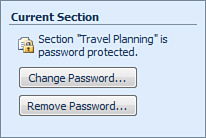Changing the Password for a Protected Section
Changing passwords is very important if you think
your original password has been compromised. This can happen if you
become aware of someone having watched your keyboard while you entered
a valid password or when someone with whom you shared a password should
no longer have access to the protected information (for example, when a
colleague at work leaves a confidential project to go work on another
team).
Provided that you have the correct password for a protected section, you can change it at any time by doing the following:
1. | Navigate to and then unlock the protected section whose password you want to change.
|
2. | In the Password Protection task pane, click Change Password (see Figure 6).

|
3. | In the Change Password dialog box that appears, first type the current password into the Old Password box. |
4. | In
the Enter New Password box, type a new password for the current
section. Remember that passwords in OneNote are case sensitive.
|
5. | In
the Confirm Password box, type the new password again. Only if this
confirmation matches the new password will OneNote change the password
for the current section.
|
If you type the original password incorrectly into
the Old Password box, or if the new password and its confirmation don’t
match, OneNote doesn’t change the current password but clears the
password fields in the Change Password dialog box so you can try again.
When the old password, new password, and new
password confirmation match, OneNote will change the password for the
current section. Depending on the speed of your computer, a progress
bar may briefly appear while OneNote is changing the password. When the
dialog box disappears, the password will have successfully been
changed. At that point, the old password for that section will no
longer unlock it. You will have to use the new password to view the
section again.
|
If you closed the Password Protection task pane and
you want to display it again, right-click the tab of any unprotected
section and then click Password Protect This Section on the shortcut
menu. When the task pane appears again, navigate to the protected
section that you want to work with by clicking its section tab.
|
Removing the Password for a Protected Section
When the notes in a protected section are not considered any more secret or sensitive in kind, you can choose to remove protection by password against this section. The elimination of a password can also be a provisional convenience all the times that you must carry out the work of edition prolonged in the sections protected by multiple and you become opposed with their automatic dead time. Naturally, in this last case, be sure to reapply
password protection to such sections again when your work is finished..
To unprotect a protected section so it no longer requires a password to be viewed, do the following:
1. | Navigate to and then unlock the protected section whose password you want to remove.
|
2. | In the Password Protection task pane, click Remove Password (refer to Figure 6).
|
3. | In the Remove Password dialog box that appears, type the current password for the section and then click OK.
|
If you enter the current password incorrectly,
OneNote won’t remove the current password. When you enter the current
password correctly, the password is removed from the current section.
You can verify this by looking at the confirmation text under the
Current Section heading near the top of the Password Protection task
pane.
|
When you no longer need the Password Protection task
pane, you can regain some screen space by closing it. To do so, click
the small X in the upper-right corner of the task pane to dismiss it.
|